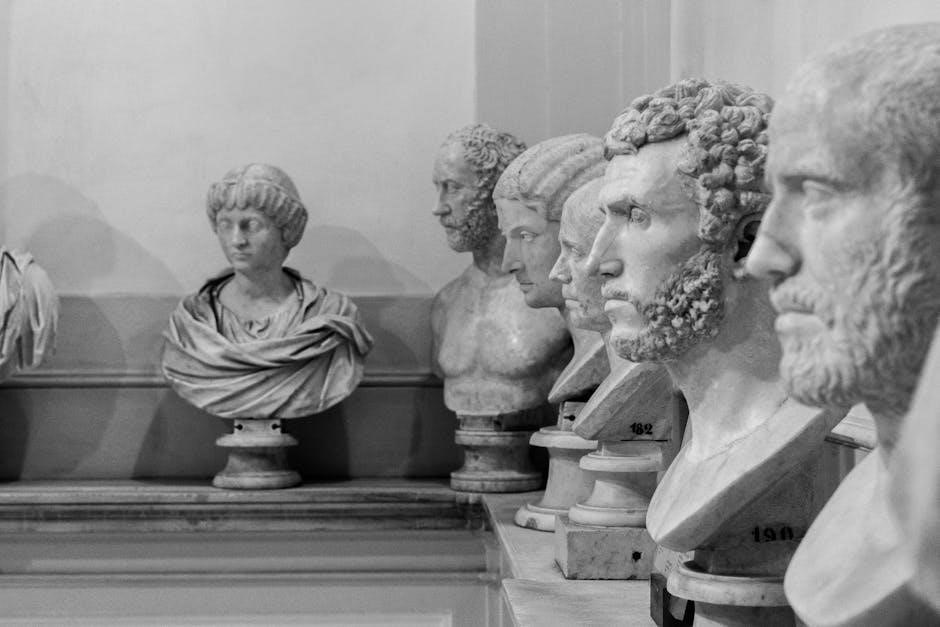Discover the timeless classic What a Wonderful World through its PDF sheet music, offering easy access to chords, lyrics, and arrangements for piano, guitar, and more. Download and enjoy this iconic song, celebrating unity and optimism, as performed by Louis Armstrong. A must-have for musicians and music lovers alike!
Overview of the Song and Its Significance
What a Wonderful World, written by George David Weiss and Bob Thiele, is a timeless classic that embodies unity and optimism. First recorded by Louis Armstrong in 1967, the song became an instant global phenomenon, transcending cultural and generational boundaries. Its heartfelt lyrics and soothing melody celebrate the beauty of life, making it a universal anthem of hope. The song’s significance lies in its ability to inspire positivity and bring people together. Over the years, it has been covered by numerous artists but remains most iconic in Armstrong’s soulful rendition. The availability of PDF sheet music has made it accessible to musicians worldwide, ensuring its legacy endures. This song is not just a piece of music but a powerful message of love and appreciation for our world.
Importance of the PDF Format for Sheet Music

The PDF format has become a cornerstone for sharing and accessing sheet music, including What a Wonderful World. Its universal compatibility ensures that musicians can open and print files across any device without losing formatting. PDFs maintain the clarity and precision of musical notation, making them ideal for both beginners and professionals. Additionally, PDFs are easily shareable, fostering collaboration among musicians. Many platforms offer free and paid versions of What a Wonderful World sheet music in PDF, catering to diverse needs. This format also allows for annotations and edits, enhancing learning and performance. With the rise of digital music, PDFs remain a reliable and accessible choice for preserving and distributing sheet music worldwide. Download your copy today and start playing!
The Song “What a Wonderful World”

A timeless classic performed by Louis Armstrong, What a Wonderful World is a heartfelt tribute to life’s beauty, written by George David Weiss and Bob Thiele in 1967.
Background and History of the Song
What a Wonderful World was written by George David Weiss and Bob Thiele and first recorded by Louis Armstrong in 1967. The song was released as a single and later included in Armstrong’s album of the same name. Despite its uplifting message, the song initially faced challenges, including limited promotion in the U.S. due to political and personal biases. However, it gained significant popularity in the U.K. and eventually became an international hit. Over time, the song has been covered by numerous artists and remains a timeless classic. Its enduring appeal lies in its optimistic lyrics and universal message of appreciation for life’s beauty. The song’s legacy continues to inspire musicians and audiences worldwide.
Lyrics and Their Meaning
The lyrics of What a Wonderful World are a poetic celebration of life’s beauty and simplicity. Lines like “I see skies of blue, clouds of white” and “The colors of the rainbow” paint vivid images of nature’s splendor. The song also reflects on human connection, with phrases like “I see friends shaking hands” and “they’re really saying, ‘I love you.'” These words convey a sense of unity and optimism. The lyrics, written by George David Weiss and Bob Thiele, emphasize gratitude for the world’s wonders, from natural beauty to the joy of human relationships. The song’s message transcends generations, resonating with listeners as a heartfelt reminder to appreciate the world’s beauty and kindness. Its timeless appeal lies in its universal and uplifting themes.
Musical Composition and Chord Progressions

What a Wonderful World features a gentle, jazzy swing rhythm that complements its uplifting lyrics. The song is written in the key of F, with chord progressions that include Bmaj7, Fmin7, Bb7, and Eb6, creating a harmonically rich yet accessible structure. The melody is simple yet emotive, allowing for expressive interpretation. The tempo is moderate, making it easy to play and sing along to. The arrangement typically includes a piano, vocal, and guitar accompaniment, with optional additions like flute or trumpet for added texture. The chord progressions and melody work together to evoke a sense of optimism and wonder, perfectly aligning with the song’s themes of unity and appreciation for life’s beauty. This composition has become a timeless standard, adaptable to various instrumental interpretations while retaining its emotional core.

PDF Sheet Music for “What a Wonderful World”
Access What a Wonderful World PDF sheet music for piano, guitar, and flute. Download free arrangements with chord progressions and lyrics, perfect for all skill levels and instruments.
Availability and Sources for Download
The PDF sheet music for What a Wonderful World is widely available online, with both free and paid versions accessible through platforms like Musicnotes, SheetMusicPlus, and BossPianoSheets. These sites offer arrangements for various instruments, including piano, guitar, and flute, ensuring versatility for musicians of all levels. Many sources provide free downloads, while others offer premium versions with additional features like chord progressions and lyrics. The PDF format allows easy printing and sharing, making it a convenient choice for practice and performance. Whether you’re a beginner or an experienced player, finding the perfect arrangement is simple with these reliable sources.
Instrument-Specific Arrangements (Piano, Guitar, Flute, etc.)
The PDF sheet music for What a Wonderful World is available in arrangements tailored to various instruments, ensuring accessibility for diverse musicians. Piano versions are particularly popular, offering both solo and accompaniment options, while guitar arrangements include chord progressions for acoustic and electric players. Flute adaptations bring a light, airy feel to the melody, making it ideal for wind instrumentalists. Additionally, arrangements for trumpet, violin, and ukulele are widely available, catering to different musical preferences. These instrument-specific versions maintain the song’s timeless charm while allowing artists to interpret it in their unique style. Whether you’re a pianist, guitarist, or flautist, there’s a version of What a Wonderful World designed to suit your skills and enhance your performance.
Free vs. Paid Versions: What’s the Difference?

When exploring What a Wonderful World PDF options, users often wonder about the differences between free and paid versions. Free versions provide basic sheet music, including chord progressions and lyrics, suitable for casual use. However, they may lack advanced features like high-quality formatting, multiple instrument arrangements, or interactive elements. Paid versions, on the other hand, offer enhanced quality, with professionally arranged scores for piano, guitar, flute, and other instruments. They often include additional resources like MIDI files, guitar tabs, or vocal guides. Paid versions also ensure legal compliance with copyright laws, supporting creators. While free versions are great for beginners, paid options are ideal for serious musicians seeking polished, versatile arrangements. Choose based on your needs and preferences for the best experience.
How to Print and Use the PDF Sheet Music
To print and use the What a Wonderful World PDF sheet music, start by downloading the file from a trusted source like MusicSheetLibrary. Ensure your printer is set to the correct paper size, typically A4 or Letter. Print the document in high-quality mode for clear readability. Once printed, organize the sheets in a binder or folder for easy access. For digital use, open the PDF on a tablet or laptop using a PDF viewer or music notation software. Many versions include interactive features, such as zoom and annotation tools, to enhance practice sessions. Whether you’re playing piano, guitar, or another instrument, the PDF format provides a versatile and convenient way to enjoy this timeless song. Happy playing!
Artists Behind the Song
Louis Armstrong, the legendary performer, brought What a Wonderful World to life. Songwriters George David Weiss and Bob Thiele crafted its timeless lyrics and melody, leaving a lasting legacy in music history.
Louis Armstrong: The Legendary Performer
Louis Armstrong, a jazz icon, famously recorded What a Wonderful World in 1967. His gravelly vocals and trumpet playing infused the song with deep emotion, making it unforgettable. Armstrong’s unique style transformed the track into a global phenomenon, despite initial modest sales in the U.S. The song’s success soared internationally, resonating with its message of unity and optimism. Armstrong’s legacy endures, with What a Wonderful World remaining his most cherished recordings. His impact on music and culture is immeasurable, solidifying his place as one of the most influential artists of the 20th century.
George David Weiss and Bob Thiele: The Songwriters
George David Weiss and Bob Thiele co-wrote the iconic song What a Wonderful World, crafting its timeless lyrics and melody. Weiss, a seasoned lyricist, and Thiele, a producer and songwriter, collaborated to create a piece that celebrated life’s beauty. The song was written for Louis Armstrong, whose unique voice brought it to life. Despite initial skepticism from some, their work became a global anthem of unity and optimism. Weiss and Thiele’s creation not only highlighted Armstrong’s talent but also left a lasting legacy in music history. Their partnership exemplifies how powerful songwriting can transcend time and touch hearts worldwide.

Cultural Impact and Legacy

What a Wonderful World has become a global anthem, spreading unity and optimism. Its enduring appeal lies in its universal message, embraced across generations and cultures. Learn more about its lasting influence and how it continues to inspire today.
The Song’s Message of Unity and Optimism
What a Wonderful World embodies a powerful message of unity and optimism, celebrating life’s beauty and humanity’s goodness. Its lyrics, filled with imagery of nature and human connection, inspire hope and joy. The song transcends racial and political divides, promoting a sense of global harmony. Armstrong’s gravelly vocals add authenticity, making the track a timeless anthem for positivity. Its uplifting melody and heartfelt words resonate universally, fostering a shared appreciation for the world’s wonders. The song’s enduring relevance lies in its ability to unite people across generations and cultures, reminding us to cherish the simple pleasures and the beauty around us. Its message remains as relevant today as it was during its release, continuing to inspire and uplift listeners worldwide.
Historical Context and Initial Reception
What a Wonderful World was released in 1967 during a time of social and political turmoil in the United States. Despite its uplifting message, the song initially faced challenges, including limited promotion by Larry Newton, who disliked the track. As a result, it sold fewer than 1,000 copies in the U.S. However, it found success in the U.K., becoming a hit. Over time, the song’s universal appeal and optimistic lyrics helped it gain international recognition. Its initial struggles contrasted with its eventual acclaim, including induction into the Grammy Hall of Fame in 1999. This journey reflects the song’s enduring ability to transcend its historical context and resonate with global audiences.
Modern-Day Popularity and Covers
What a Wonderful World remains a beloved classic, with its timeless message resonating across generations. Today, it is widely performed and covered by artists worldwide, including notable versions by Jon Batiste and others. The song’s versatility has led to adaptations in various genres, from jazz to pop, ensuring its relevance in modern music. Its enduring popularity is evident in its frequent use in films, commercials, and live performances. The availability of PDF sheet music has further fueled its accessibility, allowing musicians of all levels to play and interpret the song. This iconic piece continues to inspire new adaptations while maintaining the heartfelt essence of Louis Armstrong’s original recording. Its legacy endures as a symbol of hope and unity in contemporary culture.
Learning to Play “What a Wonderful World”
Master the timeless song with tutorials and guides tailored for all skill levels. Download the PDF sheet music to practice and perfect your performance, whether you’re a beginner or an experienced musician.
Tutorials and Guides for Beginners
Beginners can easily learn to play What a Wonderful World with free PDF tutorials and guides available online. These resources include step-by-step instructions, chord progressions, and melody lines for instruments like piano, guitar, and flute. Platforms like MuseScore and BossPianoSheets offer downloadable sheets tailored for newcomers. The song’s simple yet iconic melody makes it a great choice for practice. Tutorials often break down complex parts into manageable sections, focusing on rhythm and timing. Additionally, video guides and interactive tools provide visual aids to help beginners master the piece. With these resources, anyone can enjoy playing this timeless classic, capturing its emotional depth and uplifting spirit. Start your musical journey today by exploring these beginner-friendly materials and download the PDF to begin practicing!
Advanced Techniques for Experienced Musicians
Experienced musicians can elevate their performance of What a Wonderful World by exploring advanced techniques. The song’s chord progressions, such as Bmaj7, Fmin7, Bb7, and Eb6, offer opportunities for intricate improvisation. Musicians can experiment with nuanced dynamics, subtle tempo variations, and expressive phrasing to add depth. For pianists, advanced arrangements may include complex harmonies or jazz-inspired riffs. Guitarists can explore fingerstyle techniques or incorporate advanced chord voicings. Additionally, instrumentalists can delve into solo improvisations, blending the song’s iconic melody with personal creativity. These advanced interpretations allow musicians to showcase their skill while maintaining the song’s timeless charm. Resources like MuseScore and BossPianoSheets provide sophisticated sheet music arrangements for those seeking a challenge.
Recommended Tools and Resources
To master What a Wonderful World, musicians can utilize a variety of tools and resources. Websites like MuseScore and BossPianoSheets offer high-quality PDF sheet music for piano, guitar, and other instruments. For learners, platforms like Flowkey provide interactive lessons. TuxGuitar is ideal for editing and customizing sheet music. Additionally, apps like forScore help organize and annotate scores digitally. These resources cater to both beginners and advanced players, ensuring a seamless learning and performance experience. Explore these tools to enhance your musical journey with What a Wonderful World.
Interpretations and Arrangements
What a Wonderful World has inspired countless interpretations, from instrumental versions to vocal covers by artists worldwide. Its timeless melody adapts beautifully to various genres and cultural styles.
Instrumental Versions and Remixes
What a Wonderful World has been reimagined in various instrumental formats, including piano, guitar, flute, and trumpet arrangements. These versions highlight the song’s timeless melody and versatility. Remixes by modern artists like Jon Batiste offer fresh perspectives, blending jazz with contemporary styles. The instrumental adaptations allow musicians to explore the piece without vocals, emphasizing its emotional depth. Many of these arrangements are available as PDF sheet music, enabling performers to play along or create their own interpretations. Whether it’s a solo piano rendition or a full-band remix, the song’s essence shines through, making it a favorite for both traditional and experimental performances. Its universal appeal continues to inspire new generations of musicians and fans alike.
Vocal Performances by Other Artists
Beyond Louis Armstrong’s iconic rendition, What a Wonderful World has been beautifully interpreted by numerous artists. Vocalists like Jon Batiste and Leon Thomas have brought their unique styles to the song, infusing it with fresh energy while preserving its heartfelt message. These performances showcase the track’s versatility, adapting to various vocal ranges and genres. The song’s universal appeal is evident in its ability to resonate with diverse audiences, whether through soulful jazz deliveries or heartfelt acoustic covers. Many of these vocal renditions are available as PDF sheet music, allowing singers and musicians to explore and perform their own interpretations. Each artist’s take on the song highlights its enduring relevance and emotional depth, ensuring its legacy endures across generations and musical styles.
Cultural and Genre-Based Adaptations

What a Wonderful World has transcended cultural and genre boundaries, inspiring adaptations across the globe. From jazz renditions by Louis Armstrong to modern interpretations by artists like Jon Batiste, the song’s message resonates universally. Instrumental versions, such as trumpet and flute arrangements, highlight its melodic beauty. The track has also been reimagined in various languages, showcasing its global appeal. Additionally, genre-based adaptations, including classical, gospel, and Latin jazz interpretations, demonstrate its versatility. These adaptations, often available as PDF sheet music, allow musicians to explore diverse styles while maintaining the song’s core optimism. Such creative reinterpretations ensure What a Wonderful World remains a timeless and culturally rich piece, connecting audiences worldwide through its enduring message of unity and hope.

Conclusion
What a Wonderful World remains a timeless anthem of hope and unity, with its PDF sheet music ensuring its legacy endures. Embrace the song’s enduring appeal and explore its arrangements to keep its message alive for future generations.
Final Thoughts on the Song’s Enduring Appeal
What a Wonderful World continues to captivate audiences with its timeless message of unity and optimism. Written by George David Weiss and Bob Thiele, and immortalized by Louis Armstrong, the song transcends generations. Its gentle melody and heartfelt lyrics resonate universally, making it a beloved classic. The availability of PDF sheet music has further cemented its legacy, allowing musicians of all skill levels to play and appreciate the song. Whether for piano, guitar, or other instruments, the sheet music ensures that Armstrong’s iconic rendition lives on. The song’s enduring appeal lies in its ability to inspire hope and joy, making it a cherished piece of musical history that continues to unite people worldwide.
Encouragement to Explore and Play
Embrace the joy of music by exploring and playing What a Wonderful World using its readily available PDF sheet music. Whether you’re a beginner or an experienced musician, this timeless song offers a rewarding experience. With arrangements for piano, guitar, flute, and more, you can choose your preferred instrument. Tutorials and guides are accessible online, helping you master the piece. The song’s optimistic message and gentle melody make it a delightful addition to any repertoire. Don’t hesitate to download the PDF and start playing—let the music inspire you to appreciate the beauty of the world around you. Share your passion and enjoy the process of learning this beloved classic!
